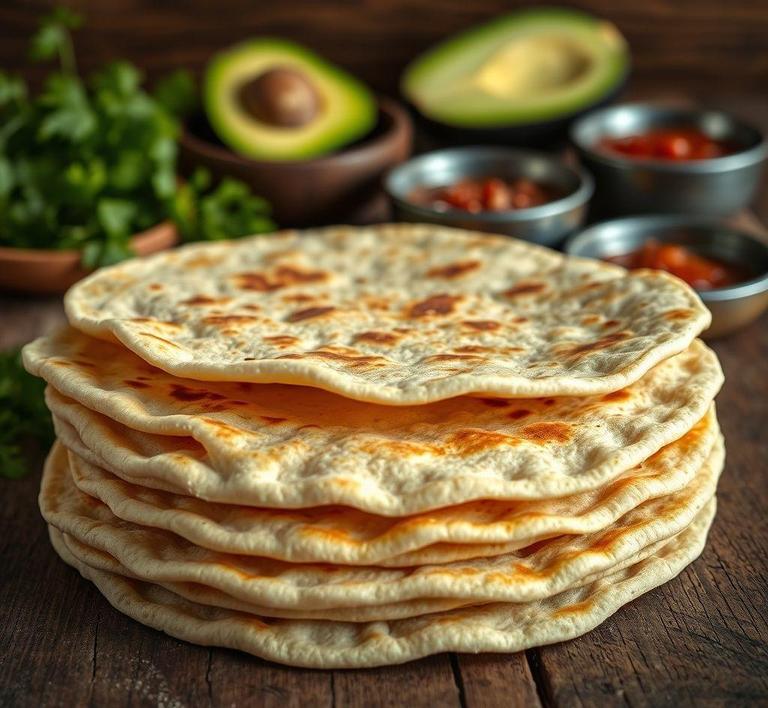If you’ve ever found yourself with a stack of leftover flour tortillas and wondered if you can save them for later, you’re in the right place! Refreezing flour tortillas is a great way to preserve their freshness and avoid food waste. In this guide, we’ll walk you through the best practices for safely refreezing your tortillas, keeping them soft and tasty when you’re ready to use them again. Whether you’re meal prepping, saving some extra tortillas from a taco night, or just looking to store them for future use, this guide will give you all the tips you need to refreeze them properly!
Can You Refreeze Flour Tortillas?

Flour tortillas are a staple in many kitchens, loved for their versatility and convenience. When it comes to freezing and refreezing them, the question often arises: Is it safe to refreeze flour tortillas once they’ve been thawed?
Technically, yes, you can refreeze flour tortillas, but there are important caveats to consider. From a food safety perspective, refreezing any food that has been thawed can be risky if the tortillas were left out at room temperature for too long or if they show signs of spoilage. Bacteria multiply quickly at temperatures between 40°F (4°C) and 140°F (60°C), known as the "danger zone," so if the tortillas have been in this zone for more than two hours after thawing, refreezing is not recommended.
If you thaw tortillas in the refrigerator and keep them cold, the risk of harmful bacterial growth is minimized, making refreezing generally safe. However, repeated freezing and thawing can affect the texture and moisture content, which impacts the overall quality.
In essence:
- Safe refreezing is possible if tortillas have been properly thawed in the fridge and haven’t spent extended time at room temperature.
- Avoid refreezing if tortillas feel soggy, dry, or exhibit any signs of mold or off smell.
So yes, from a safety standpoint, you can refreeze, but it should be done thoughtfully.
How To Refreeze Flour Tortillas?
Refreezing tortillas properly is crucial to maintaining as much of their original quality as possible. Here’s a step-by-step guide to ensure you do it right:
-
Thawing First Time:
Always thaw your flour tortillas in the refrigerator, ideally overnight. This slow thaw keeps them at a safe temperature and preserves moisture.
-
Check Quality:
Before refreezing, inspect the tortillas. If they are still pliable, free of moisture accumulation, and smell normal, they’re good to go. Avoid refreezing if they seem overly dry, brittle, or damp.
-
Repackaging:
Use airtight packaging to prevent freezer burn. Place the tortillas in a resealable freezer bag or wrap them tightly in plastic wrap, then place them in a freezer-safe container or bag to provide a double layer of protection.
-
Label and Date:
Always label your package with the date so you can keep track of how long they’ve been frozen. Ideally, consume within 1-2 months for best taste.
-
Freeze Quickly:
Place the tortillas in the coldest part of your freezer to ensure they freeze as quickly as possible, minimizing ice crystal formation that can damage texture.
-
Thawing Next Time:
When ready to use again, thaw in the refrigerator again or heat directly from frozen on a skillet or microwave with a damp paper towel to restore softness.
By following these steps, you can refreeze your flour tortillas with minimal degradation and keep them ready for future meals.
Quality Impact
While refreezing is safe under proper conditions, the quality of flour tortillas does take a hit each time they go through the freezing and thawing cycle.
-
Texture Changes:
Flour tortillas rely heavily on moisture and gluten structure for their soft, flexible texture. Freezing forms ice crystals within the dough, which can rupture gluten strands. Upon thawing, this can lead to tortillas that are slightly tougher or drier. Refreezing compounds this effect, sometimes resulting in a less pliable tortilla that may crack or tear when folded.
-
Moisture Loss or Excess:
If not wrapped tightly, tortillas can suffer freezer burn, where dry air dehydrates their surface, making them crumbly or brittle. Alternatively, condensation during thawing can make them soggy or sticky.
-
Flavor Degradation:
Extended freezing or repeated freezing cycles may dull the subtle wheat flavor and cause stale or off notes, especially if packaging isn’t airtight.
-
Appearance:
Sometimes refrozen tortillas might develop slight discoloration or a less appetizing look, though this is mostly cosmetic.
Despite these quality impacts, tortillas are still quite forgiving. Using a warming method like a hot skillet or microwave with a damp towel can help restore some softness and elasticity.
you absolutely can refreeze flour tortillas, but it’s best done with care to ensure safety and maintain quality. Proper refrigeration during thawing, careful inspection before refreezing, and airtight packaging are essential steps. While refreezing does impact texture and flavor, many people find it a practical way to reduce food waste and keep their tortilla stash ready for spontaneous meals.
If you anticipate needing tortillas over a longer period, consider freezing in smaller batches to minimize the need for refreezing. And always aim to consume refrozen tortillas within a couple of months to enjoy them at their best.
Is It Safe To Refreeze Flour Tortillas?
Flour tortillas are a staple in many households-versatile, convenient, and delicious. But what happens if you thaw a batch, use a few, and wonder if you can safely toss the rest back in the freezer? The safety and quality of refreezing flour tortillas depend heavily on how they were handled during the thawing and storage process.
From a food safety perspective, flour tortillas, like most bread products, are relatively low risk when refrozen if handled properly. They don’t harbor harmful bacteria like raw meat or dairy products, but moisture and warmth can create an environment where mold spores or bacteria could grow. Therefore, if tortillas were thawed in the refrigerator and kept at a safe temperature (below 40°F or 4°C), refreezing is generally safe. The key is avoiding prolonged time at room temperature, which can accelerate spoilage.
However, quality-wise, refreezing can slightly affect the texture. Tortillas have a delicate balance of moisture and flour, and freezing forms ice crystals that disrupt this. When thawed and refrozen, these crystals may become larger, resulting in a slightly drier or tougher tortilla after reheating. If your tortillas are freshly made or high quality, this textural degradation is more noticeable.
In summary, it’s safe to refreeze flour tortillas if:
- They were thawed properly in the fridge.
- They have not been left out for more than two hours at room temperature.
- They show no signs of spoilage (no mold, off smell, or sliminess).
Signs That Flour Tortillas Should Not Be Refrozen
Knowing when not to refreeze is crucial to avoid foodborne illnesses or disappointing textures. Here are some red flags that mean your tortillas should be tossed, not refrozen:
- Visible Mold or Discoloration: Flour tortillas, once mold appears, should be discarded immediately. Mold is a clear indicator of spoilage and can cause health risks.
- Unpleasant Odor: A sour, musty, or fermented smell means the tortillas have begun to spoil. Since flour tortillas don’t have a strong aroma normally, any strange odor is a bad sign.
- Slimy or Sticky Texture: If the tortillas feel unusually damp or sticky, especially between layers, this could mean bacterial or fungal growth has begun.
- Warm or Room Temperature Storage for Extended Period: Tortillas left out for over two hours at room temperature or thawed outside the fridge increase the risk of contamination. If you find tortillas that have been left out too long, avoid refreezing.
- Freezer Burn or Excess Dryness: If the tortillas are already freezer-burned (dry, leathery patches), refreezing will only make them worse. They won’t regain their original softness or flavor.
In short, trust your senses and err on the side of caution. If any signs of spoilage are present, it’s safer to throw the tortillas away.
Common Refreezing Mistakes
Refreezing flour tortillas might seem simple, but many people unknowingly make mistakes that degrade quality or risk safety:
- Refreezing After Leaving Tortillas Out Too Long: The most common error is leaving thawed tortillas at room temperature for hours before deciding to refreeze them. This can foster bacterial growth.
- Refreezing Multiple Times: Each freeze-thaw cycle causes moisture loss and texture degradation. Constant refreezing leads to dry, brittle tortillas that crumble instead of fold.
- Improper Packaging: If tortillas are refrozen without being wrapped tightly or sealed properly, they’re prone to freezer burn. Exposure to air dries them out and ruins flavor.
- Not Cooling Before Refreezing: Sometimes people re-freeze tortillas while they are still warm or even hot from recent cooking or thawing. This causes condensation inside packaging, leading to ice crystals and soggy texture.
- Ignoring Storage Time: Even in the freezer, tortillas don’t last forever. Refreezing tortillas that have already been frozen for months reduces freshness and quality. Ideally, freeze tortillas for no longer than 2-3 months.
Avoiding these mistakes will help you preserve the best texture, flavor, and safety of your flour tortillas.
Tips And Tricks
Want to master the art of freezing and refreezing flour tortillas? Here are some pro tips that will keep them tasting fresh and pliable:
- Freeze in Small Batches: Divide tortillas into small stacks (4-6 pieces) and wrap each stack tightly with plastic wrap or aluminum foil before placing in a freezer bag. This minimizes exposure and allows easy thawing of only what you need.
- Use Airtight Packaging: Vacuum sealing is the gold standard to prevent freezer burn. If you don’t have a vacuum sealer, squeeze out as much air as possible from resealable bags.
- Label and Date: Always mark the date of freezing on the package. Use the oldest first to avoid long-term storage.
- Thaw Gradually: For best results, thaw tortillas overnight in the fridge rather than on the counter. This slows moisture loss and prevents condensation buildup.
- Reheat Gently: When reheating thawed tortillas, use a warm skillet or microwave with a damp paper towel to maintain moisture and softness.
- Avoid Refreezing After Cooking: If you’ve cooked tortillas (e.g., grilled or toasted), it’s best not to refreeze them. Cooked tortillas don’t freeze as well and lose quality quickly.
Following these tips will ensure your tortillas stay soft, flexible, and tasty, even after freezing and refreezing.
Conclusion
Refreezing flour tortillas is generally safe when done correctly, but requires mindful handling to maintain both safety and quality. Proper storage, quick refrigeration, and airtight packaging help preserve tortillas for multiple uses without sacrificing flavor or texture. However, it’s essential to watch for signs of spoilage such as mold, off odors, or sliminess, and avoid common mistakes like refreezing after leaving tortillas out at room temperature.
With careful attention and smart freezing techniques, you can extend the life of your tortillas and reduce food waste, ensuring your wraps, quesadillas, and burritos remain fresh and delicious every time. So next time you wonder if those leftover tortillas can go back in the freezer, remember these guidelines and enjoy the convenience without compromise!


